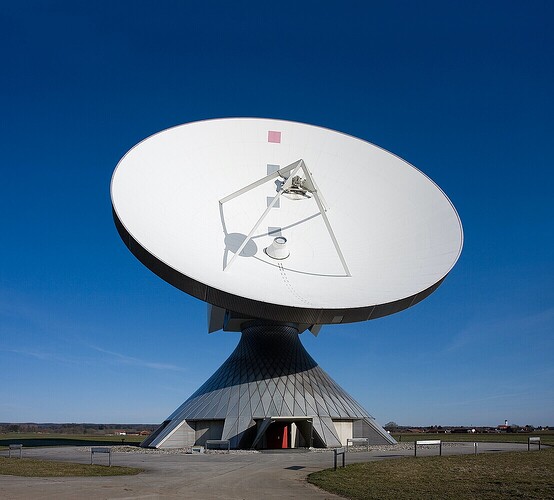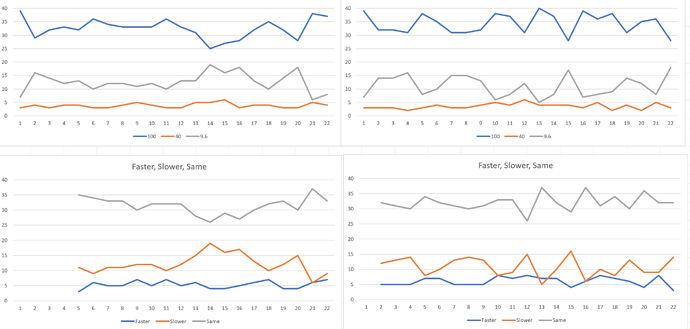As I said before, I'm in a one story condo, so the multi-story part doesn't concern me. What I don't get from the diagram is that if the 5 dbi and above antenna's are so directional how does that work for a rectangular unit? Would I have to put the hub in a far corner and angle it out say about 45 degrees to get the maximum coverage? It seems that if the hub is centrally located, with the 5 dbi and above, anything that was off axis won't get any signal, which would be a vast swath of my place. And how does one determine which direction those cones are formed? (i.e. which is the front and which is the side?) Should the 2 be mounted 90 degrees from each other to get the best coverage? Sorry to be such a noob, but I've never had any experience with how these work or shoudl be set up.
As I understand it, if you're looking down at the antenna from above with it pointing up at you (or down away from you) the broadcast is shaped more like an apple for the 2db antenna, and more like a wide/flat donut w/the 9db.
So the 2db "apple" shape gets you more coverage between floors, but less coverage laterally across your house. The 9db flat donut shape gets you less coverage between floors, but wider coverage across the lateral distance in your house. Best position for the antenna is usually at or close to the center of your living space, and the antenna should always be positioned vertically, pointing up or down (doesn't matter if it's pointing up or down).
Said a bit differently, the pictures are a vertical plane slicing through the antenna. Rotate those pictures about the axis of the antenna to get a 3-D coverage pattern. All of the antenna patterns are axially symmetric.
Now, my antenna is a bit more directional:
LOL on the space antenna. I think I'm getting it a bit more, and explains why higher dbi is worse between floors.
So next question: I have 2 plugs that sit on the floor about 2-3 feet to the right of my being directly beneath the hub. (The hub is on top of a (mostly) wood cabinet which I would guess is about 7 feet tall). Would those 5+ antennas then see the plugs or would they have to be further to the side of the hub?
While the hub improved today in the # of devices at 100, it is still up and down and a very significant (10 of 49) devices are still at 9.6 vs the C-7 and most went from 100 to 9.6 while only 5 of the 49 are connecting faster than they were on the C-7.
So I am thinking of trying a different antenna. Given the mysterious ways of Z-Wave should I see results almost instantaneously or still expect a couple of week wait? And, it was never really answered, when people say it can take a couple of weeks, is it a gradual improvement or it suddenly happens mostly all at once?
Example of a plane about to slice through an antenna. This antenna technology is pretty cool... ![]()
Don't worry about the plugs...they will connect, either directly, or via nearby repeater. Should not be an issue. I have had devices in the same room as the hub connect via another device outside the room - no idea if it's about the signal shape or just dumb luck, but in either case (direct or repeater connect) I haven't found issues.
RF lobes are weird...especially trying to paint a picture. Don't take the lobe shapes in those charts literally. There's definitely RF bleed past the lines drawn. The idea of the image is to show were 95% of the RF energy is going. They'll connect just fine.
Since I live in a 2,500 sq. ft. rectangular condo that is all on 1 floor I went ahead and ordered the 8 dbi "flat" version of these antennas:
https://www.amazon.com/gp/product/B09NPH2X8F/ref=ppx_od_dt_b_asin_title_s00?ie=UTF8&psc=1
They should be here Saturday and, of course, I'll report in as to whether or not they help or hurt.
Good to hear.
Remember it will likely take some time for the new antenna to have an effect on your mesh. In some cases you could remove/re-pair devices that you are are paritcularly concerned about.
Thank you. While I've been reminded repeatedly that it could take some time no one ever answers if I should see some gradual improvement, like a device or 2 getting better each day or so (e.g. connecting directly or faster), or does it typically happen all at once, i.e. I might not see anything for days then all of a sudden a whole bunch will connect more directly/faster?
It should happen gradually.
Yes, what he said. 
Hmmm. That's what I was assuming. It's been about 3-4 weeks now, and I'm literally at the exact same place I was just after installing the C-8 and doing the suggested antenna swap. Yuck! (5 faster, 12 slower and 32 the same speed as I was on the C-7, which is 3 faster than before the antenna swap). But, since I live on one floor, as I understand it, the horizontal coverage isn't important to me (I hope) so I ordered a pair 9 dbi antennas that will arrive tomorrow. (Saturday, May 13, 2023). Let's see if they help at all.
The antenna swap on the C8 (swap one C8 antenna for the other) would only help if one of the antennas had a fault on its Z-Wave side. If both antennas are OK (no faults) then maybe for some reason the stock antennas just don't play well in your environment. Hopefully the new antenna will result in some changes.
I know the hub orientation for most antennas doesn't matter as they are basically round, but the ones I got are shaped like rectangles (see below). My condo is a rectangle with the long side going north to south. My hub is pretty centrally located but just a bit to the west side. The areas I'm having trouble with are most the NE and SE corners. Does it matter which direction these particular antennas are facing? If so, should the flat part be in-line or 45 or 90 degrees from the main N-S axis? (And if not, is there any reason they are shaped like this and not just a typical round antenna?)
Radiation should be perpendicular to the plane of those rectangular antennas.
Thanks. Since my unit's long ways is N-S I would want then lined up E-W so the wide flat sides are facing North & South, correct?
I wanted to wait at least a couple of weeks to see how the new antenna would work after I did the pivot. 19 days later the net result is that I'm still getting inferior performance than the C-7.
I installed the C-8 in early-mid April and my connections were “better” only 1 day since them. (By better I mean more devices were connecting faster than slower). I switched the original antennas as they thought one might be bad, but that didn’t help. I then bought a bigger antenna, one that is rectangular shaped and tried it with the flat side parallel to my house, and when that didn’t help, turned it 90 degrees, and that still hasn’t helped.
I created some macros in Excel and copy, paste, and massage the Z-Wave table every day, typically in the morning, to, hopefully, remove that as a variable. As I mentioned above, except for 1 day (when I was 1 net device faster than slower) every single day since installing the C-8 I’ve had more devices connecting slower then before then are now connecting faster then they were on the C-7.
I had 49 devices and on the last C-7 day, in 100, 40, 9.6 order I had:
100 = 39
40 = 4
9.6 = 7
Today, 19 days after they suggested I do the 90 degree pivot so the flat side of the antennas were perpendicular to the main home angle I’m at.
100 = 38
40 = 4
9.6 = 7
With 5 faster, 6, slower and 38 unchanged. This is one of my best days. I am often much worse than that. Below is the screenshot I made of graphs of the speeds and faster/slower/same. The first data point is where the C-7 was. As you’ll see, especially from the bottom graphs, except for that one day I’ve always had more devices being slower on the C-8 then were faster with it. (In the bottom 2 charts the orange is slower and the blue is faster). So, at least from my experience, the C-8 has been a big bust and waste of money as I’m getting inferior performance.
I had posted an update elsewhere, but thought it important to post an update here as well. I had my C-7, and now my C-8, plugged into a TP-Link satellite router that was lying on its side to help hide it. When I stood the TP-Link I immediately got better results - more devices at 100 and more with less hops, of which more were directly connected. As everything is working pretty well I did not hook the C-7 back up to see how it would do. So it may have been the interference from the TP-Link, but even so, the C-7 and C-8 were in virtually the same spot so if it was interference the C-8 was adversely affected more.
I have moved the C-8 a couple of more feet away from the TP-Link but that does not appear to have made any positive difference.
So my bottom line is that I cannot say I have seen any benefit I can directly associate to the C-8 yet.




